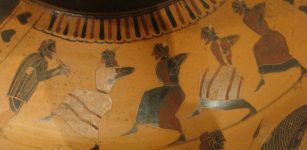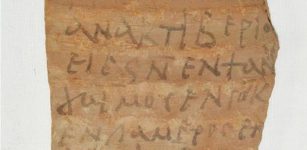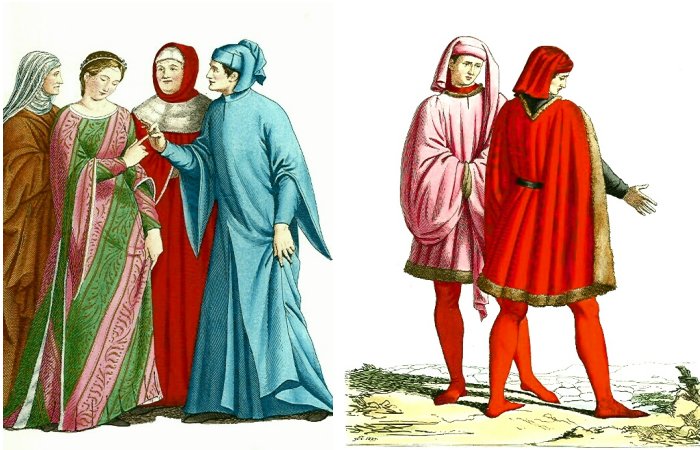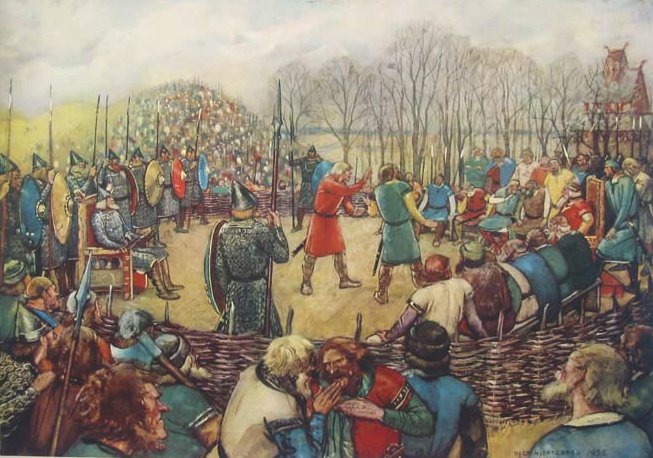Why Were Medieval People Easily Offended And Scared Of Rumors?
Ellen Lloyd - AncientPages.com - Anyone can be offended by anything at any time today. We see this almost every day, especially on social media, but looking through the eyes of modern society, one can say that Medieval people were extremely easily offended and were very scared of rumors. History shows this behavior can be explained, and there are valid reasons why insults could not be tolerated during the Middle Ages.
During the Middle Ages, honor and courage were highly significant, and injustice could have fatal consequences. Medieval knights followed chivalry - the lifestyle and moral code based on values such as honor, bravery, courteousness, and honesty.
The medieval tradition of chivalry did not survive because of the political situation in Europe following the Renaissance. Credit: Public Domain
Insults could lead to death. In some countries like Iceland and Ireland, it was common to humiliate others by performing satirical songs. “The most effective, these songs were to be performed not only in public but also in the presence of the intended victim.
The effects of such open insults were terrible and lasting, and little remained for the victim other than revenge or death. The most heinous of all accusations were the ergi (sing., argr or ragr), which included not only such acts as homosexuality, pederasty, and sodomy, but also such crimes as cowardice in battle, treason, heresy, perjury, and murder. In Iceland, as in Ireland, the task of performing public ridicule was entrusted to the professional singer-poets, the Skalds.” 1
You Could Be Convicted Based On Rumors
According to Ole-Albert Rønning Nordby from the University of Oslo in Norway, many Medieval deaths were caused by rumors. Rumors and accusations could have fatal consequences for the victim. Nordby explained that rumors during the Middle Ages had the same weight as evidence today. If there was a rumor that a man had been unfaithful, and he could not prove this accusation false, he could be punished. Basically, rumors could start an investigation, and an uncertain or doubtful truth could get convicted.
The practice of law and justice in the Middle Ages was different from our modern system. If you were accused, you had to face a trial and swear an oath, but the sworn oath had a different weight than today.
Left: Illustration of Renaissance clothing by Paul Mercuri from "Costumes Historiques" (Paris, ca.1850′s or 60’s). Credit: Public Domain - Right: Illustration of Renaissance clothing by Paul Mercuri from "Costumes Historiques" (Paris, ca.1850′s or 60’s). Credit: Public Domain
Nordby, who studied how justice in Scandinavia worked during the Middle Ages, focusing on the importance of sworn oaths for the judicial process, explained the system was completely different from what we are accustomed to today.
During the Middle Ages, it was not enough that you placed your hand on the Bible and swore to tell the truth and nothing but the truth. You could swear you were innocent, but this was by no means enough. You also had to have witnesses who could attest that you were not the kind of person who could commit this particular type of crime. In other words, you needed character witnesses. In the case of infidelity, two additional persons besides yourself must certify that you have not been unfaithful. If they testified in your favor, then the case was closed, and you were declared innocent.
A False Testimony Was Dangerous
Going to court and giving a false testimony was very dangerous and the worst thing a person could do. Nordby explained it was much better to admit the truth than to lie. A person who lied lost the right to defend himself and risked being outlawed.
A witness who was called to testify could never be of lower social status than the accused. A newly released slave, for example, could not testify against or for his former master. Nordby suggests this prevented the rich from bribing the poor to testify in their favor.
In those days, judges could not rely on technical evidence, but it’s interesting to note that eyewitnesses had a much higher Medieval court value than a sworn oath. Nordby’s research also revealed that the burden of proof during the Middle Ages lay on the accused, not the prosecutor as it is today.
There were many differences, and proving your innocence could be extremely difficult in many cases. It could also take a long time before you received your verdict.
Some aspects of the Medieval judiciary remind us of the Viking Thing system. The Thing was the governing assembly made up of the free people of the community. Each community had its own independent Thing where all free Vikings could gather to make law, resolve disputes, and make decisions. The meeting place was called a thingstead.
The Thing met at specific, regular times and meetings could sometimes last for several days. Each Thing had a law speaker who would recite the law from memory. Illustration by Hjortzberg, O. 1932 - Norstedt und Söner/Westermann/Esselte/Stockmann, P., Stockholm - Public Domain
In Viking society, people sometimes decided to solve a matter through a challenge. This was done by a Holmgang, a duel that had to take place within three to seven days after the challenge was announced.
The Thing system was considered better than having disputes settled by duel or family feuds.
Those who faced a trial at the Thing knew the verdict could devastate their lives. People who were found guilty were either fined, declared semi-outlaw, or fully outlawed. To be an outlaw was a dreadful punishment for a Viking, as it resulted in being banished from society and having one's property confiscated.
Updated on October 1, 2023
Written by Ellen Lloyd – AncientPages.com
Copyright © AncientPages.com All rights reserved. This material may not be published, broadcast, rewritten or redistributed in whole or part without the express written permission of AncientPages.com
Expand for references- Ward, Donald. "Honor and Shame in the Middle Ages: An Open Letter to Lutz Röhrich." Jahrbuch Für Volksliedforschung27/28 (1982): 1-16. doi:10.2307/848480.
- Aftonbladet
- George Burton Adams - Civilization During the Middle Ages
- Freeman, Henry - The Middle Ages: A History From Beginning to End
More From Ancient Pages
-
 On This Day In History: Gerardus Mercator Famous Mapmaker Of All Time Died – On Dec 2, 1594
News | Dec 2, 2016
On This Day In History: Gerardus Mercator Famous Mapmaker Of All Time Died – On Dec 2, 1594
News | Dec 2, 2016 -
 Unique Page From Rare Illuminated Manuscript And Thousands Of Treasures Found Under The Floor Of Oxburgh Hall
Archaeology | Aug 18, 2020
Unique Page From Rare Illuminated Manuscript And Thousands Of Treasures Found Under The Floor Of Oxburgh Hall
Archaeology | Aug 18, 2020 -
 Dance Was A Gift Of The Gods To Ancient Greeks
Featured Stories | Oct 4, 2021
Dance Was A Gift Of The Gods To Ancient Greeks
Featured Stories | Oct 4, 2021 -
 Mysterious 2,800-Year-Old Channel Installation Discovered In The City Of David, Jerusalem
Archaeology | Aug 30, 2023
Mysterious 2,800-Year-Old Channel Installation Discovered In The City Of David, Jerusalem
Archaeology | Aug 30, 2023 -
 Huge Ancient Ceramic Workshop With Hundreds Of Stunning Artifacts Solves An Archaeological Mystery In Israel
Archaeology | Dec 14, 2020
Huge Ancient Ceramic Workshop With Hundreds Of Stunning Artifacts Solves An Archaeological Mystery In Israel
Archaeology | Dec 14, 2020 -
 Incredible Ancient Roman ‘Service Station’ With Hundreds Of Artifacts And Dozens Bodies Found In Hertfordshire, UK
Archaeology | May 12, 2022
Incredible Ancient Roman ‘Service Station’ With Hundreds Of Artifacts And Dozens Bodies Found In Hertfordshire, UK
Archaeology | May 12, 2022 -
 Study Traces DNA Of Inca Emperors To Their Modern-Day Descendants
Archaeology | May 29, 2018
Study Traces DNA Of Inca Emperors To Their Modern-Day Descendants
Archaeology | May 29, 2018 -
 Sea Sequin ‘Bling’ Links Indonesian Islands’ Ancient Communities
Archaeology | Aug 16, 2023
Sea Sequin ‘Bling’ Links Indonesian Islands’ Ancient Communities
Archaeology | Aug 16, 2023 -
 Mystery Of The Neanderthals – Search For Traces Of Neanderthals’ Lives And Hints Of Their Demise
Archaeology | Sep 26, 2022
Mystery Of The Neanderthals – Search For Traces Of Neanderthals’ Lives And Hints Of Their Demise
Archaeology | Sep 26, 2022 -
 Mysterious Ancient Spiral Structure And Buried Towers Discovered At Angkor Wat
Archaeology | Dec 9, 2015
Mysterious Ancient Spiral Structure And Buried Towers Discovered At Angkor Wat
Archaeology | Dec 9, 2015 -
 New Fossil Of 145-Million-Year-Old Pterosaur Nicknamed Elvis
Fossils | Jul 14, 2023
New Fossil Of 145-Million-Year-Old Pterosaur Nicknamed Elvis
Fossils | Jul 14, 2023 -
 Evidence Humans Have Been Using Bear Skins For At Least 300,000 Years Discovered
Archaeology | Dec 27, 2022
Evidence Humans Have Been Using Bear Skins For At Least 300,000 Years Discovered
Archaeology | Dec 27, 2022 -
 Roman Ship Cargo And Galley Equipment Discovered Underwater In The Caesarea Harbor
Archaeology | Sep 12, 2023
Roman Ship Cargo And Galley Equipment Discovered Underwater In The Caesarea Harbor
Archaeology | Sep 12, 2023 -
 Mysterious Balochistan Sphinx Has An Ancient Story To Tell – But Is An Advanced Ancient Civilization Or Mother Nature Hiding Behind The Story?
Featured Stories | Feb 3, 2018
Mysterious Balochistan Sphinx Has An Ancient Story To Tell – But Is An Advanced Ancient Civilization Or Mother Nature Hiding Behind The Story?
Featured Stories | Feb 3, 2018 -
 Two Well-Preserved Shipwrecks Found By Swedish Maritime Divers In Baltic Sea
Archaeology | Jan 30, 2018
Two Well-Preserved Shipwrecks Found By Swedish Maritime Divers In Baltic Sea
Archaeology | Jan 30, 2018 -
 Ancient Sahul: Its Submerged Landscapes Reveal A Mosaic Of Human Habitation
Archaeology | Dec 26, 2023
Ancient Sahul: Its Submerged Landscapes Reveal A Mosaic Of Human Habitation
Archaeology | Dec 26, 2023 -
 Mysterious Ancient People Who Mastered Thought-Transmission Through Space And Spoke At Distance
Featured Stories | Apr 26, 2021
Mysterious Ancient People Who Mastered Thought-Transmission Through Space And Spoke At Distance
Featured Stories | Apr 26, 2021 -
 Unique Virtual Look At Gamla Uppsala: Sacred Ancient Viking And Pagan Site In Sweden
Civilizations | Sep 19, 2016
Unique Virtual Look At Gamla Uppsala: Sacred Ancient Viking And Pagan Site In Sweden
Civilizations | Sep 19, 2016 -
 Peru’s Wari Culture And Their Ancient ‘Amunas’ Will Help Peru’s Water
Ancient Technology | Apr 13, 2015
Peru’s Wari Culture And Their Ancient ‘Amunas’ Will Help Peru’s Water
Ancient Technology | Apr 13, 2015 -
 Rare Discovery Of More Than 18,000 Inscribed Pot Sherds Document Life In Ancient Egypt
Archaeology | Jan 31, 2022
Rare Discovery Of More Than 18,000 Inscribed Pot Sherds Document Life In Ancient Egypt
Archaeology | Jan 31, 2022



